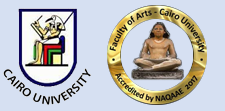عنوان المقال عربي
《北京折叠》与《乌托邦》中“空间元素” 的相同点分析 تشابه عنصر المکان بين روايتي "بکين تنطوي" لـخاو جينج فانغ و"يوتوبيا" لـ أحمد خالد توفيق مقارنة أدبية
Document Type
Original Study
Keywords English
similarities, social space, ANALYZE
Abstract English
First published in 2012 by the Chinese science fiction writer HAO JING FANG`s Novel, who won the 74th Hugo Award, the short novel "FOLDING BEIJING" and the novel that our Egyptian science fiction writer AHMEDꓸ KHALIDꓸ TAWFIK published in 2008 "Utopia" which have been reviewed by the United Kingdom famous NEWS PAPER "The Independent" by Sholto Byrnes, the two writers coincidentally created a quiet similar Novel space element with a strong dystopian color of science fiction literature , sharply reflects the society of a crowded city with a great sense of Class societal conflict in the near future,”folding Beijing “ has divided the people into three classes : lower class, middle class and upper class people, “ UTOPIA” divided people into two classes: lower class and upper class. This article attempts to analyze the similarities in the place element with its tangible and social intangible branches between the two novels "Beijing Folding" and "Utopia".
الملخص العربي
يتناول البحث التحليل الأدبي لـ عنصر المکان في رواية " بکين تنطوي " التي نشرت للمرة الأولى في عام 2012 والحائزة على جائزة هوغو رقم 74 لکاتبة الخيال العلمي الصينية هاو جينغ فانغ ، والرواية المصرية " يوتوبيا" لکاتب الخيال العلمي المصري أحمد خالد توفيق، والتي نشرت عام 2008 ،وتمت مراجعتها من قبل شولتو بيرنز- صحيفة الإندبندنت الشهيرة، حيث تتشارک الروايتان عنصراُ مکانيا مماثلا إلى حد کبير مع لون ديستوبي قوي لأدب الخيال العلمي، وتعکسان بشکل حاد مجتمع مزدحم مع وجود شعور عظيم بالصراع المجتمعي الطبقي , "بکين تنطوي" قسمت المجتمع إلى ثلاث طبقات: الطبقة الدنيا والطبقة الوسطى والطبقة العليا ،بينما قسمت "يوتوبيا" المجتمع إلى طبقتين: الطبقة الدنيا والطبقة العليا. يحاول هذا المقال تحليل أوجه التشابه في عنصر المکان تقصيليا بين الروايتين
Recommended Citation
Abdel Badie, Nouran
(2022)
"《北京折叠》与《乌托邦》中“空间元素” 的相同点分析,"
Journal of the Faculty of Arts (JFA): Vol. 82:
Iss.
2, Article 6.
DOI: https://doi.org/10.21608/jarts.2021.70129.1125
Digital Object Identifier (DOI)
10.21608/jarts.2021.70129.1125
Accept Date
2021-05-29
Publication Date
4-1-2022

